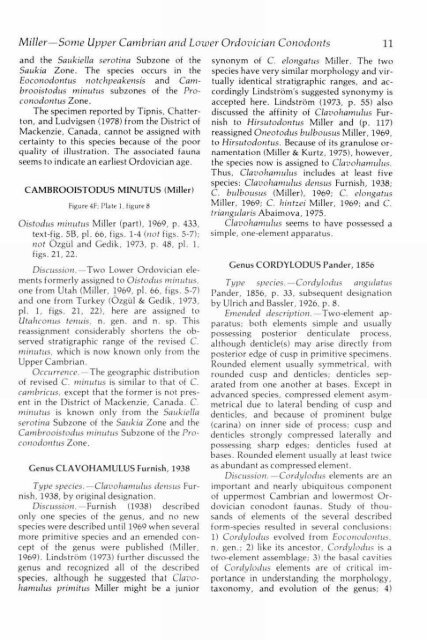View - KU ScholarWorks - University of Kansas
View - KU ScholarWorks - University of Kansas
View - KU ScholarWorks - University of Kansas
Create successful ePaper yourself
Turn your PDF publications into a flip-book with our unique Google optimized e-Paper software.
Miller—Some Lipper Cambrian and Lower Ordovician Conodonts 11<br />
and the Saukiella serotina Subzone <strong>of</strong> the<br />
Saukia Zone. The species occurs in the<br />
Eoconodontus notch peakensis and Cambrooistodus<br />
minutus subzones <strong>of</strong> the Proconodontus<br />
Zone.<br />
The specimen reported by Tipnis, Chatterton,<br />
and Ludvigsen (1978) from the District <strong>of</strong><br />
Mackenzie, Canada, cannot be assigned with<br />
certainty to this species because <strong>of</strong> the poor<br />
quality <strong>of</strong> illustration. The associated fauna<br />
seems to indicate an earliest Ordovician age.<br />
CAMBROOISTODUS MINUTUS (Miller)<br />
Figure 4F; Plate 1, figure 8<br />
Oistodus minutus Miller (part), 1969, p. 433,<br />
text-fig. 5B, pl. 66, figs. 1-4 (not figs. 5-7);<br />
not Ozgi.il and Gedik, 1973, p. 48, pl. 1,<br />
figs. 21, 22.<br />
Discussion. —Two Lower Ordovician elements<br />
formerly assigned to Oistodus minutus,<br />
one from Utah (Miller, 1969, pl. 66, figs. 5-7)<br />
and one from Turkey (Ozgill & Gedik, 1973,<br />
pl. 1, figs. 21, 22), here are assigned to<br />
LItaliconus tenuis, n. gen. and n. sp. This<br />
reassignment considerably shortens the observed<br />
stratigraphic range <strong>of</strong> the revised C.<br />
minutus, which is now known only from the<br />
Upper Cambrian.<br />
Occurrence. —The geographic distribution<br />
<strong>of</strong> revised C. minutus is similar to that <strong>of</strong> C.<br />
cambricus, except that the former is not present<br />
in the District <strong>of</strong> Mackenzie, Canada. C.<br />
minutus is known only from the Saukiella<br />
serotina Subzone <strong>of</strong> the Saukia Zone and the<br />
Cambrooistodus minutus Subzone <strong>of</strong> the Pro<br />
tus Zone.<br />
-conodon<br />
Genus CLAVOHAMULUS Furnish, 1938<br />
Type species. — Clavohamulus densus Furnish,<br />
1938, by original designation.<br />
Discussion. — Furnish (1938) described<br />
only one species <strong>of</strong> the genus, and no new<br />
species were described until 1969 when several<br />
more primitive species and an emended concept<br />
<strong>of</strong> the genus were published (Miller,<br />
1969). Lindstrom (1973) further discussed the<br />
genus and recognized all <strong>of</strong> the described<br />
species, although he suggested that Clavohamulus<br />
primitus Miller might be a junior<br />
synonym <strong>of</strong> C. elongatus Miller. The two<br />
species have very similar morphology and virtually<br />
identical stratigraphic ranges, and accordingly<br />
LindstrOm's suggested synonymy is<br />
accepted here. LindstrOm (1973, p. 55) also<br />
discussed the affinity <strong>of</strong> Clavohamulus Furnish<br />
to Hirsutodontus Miller and (p. 117)<br />
reassigned Oneotodus bulbousus Miller, 1969,<br />
to Hirsutodontus. Because <strong>of</strong> its granulose ornamentation<br />
(Miller & Kurtz, 1975), however,<br />
the species now is assigned to Clavohamulus.<br />
Thus, Clavohamulus includes at least five<br />
species: Clavohainulus densus Furnish, 1938;<br />
C. bufbousus (Miller), 1969; C. elongatus<br />
Miller, 1969; C. hintzei Miller, 1969; and C.<br />
triangularis Abaimova, 1975.<br />
Clavohamulus seems to have possessed a<br />
simple, one-element apparatus.<br />
Genus CORDYLODUS Pander, 1856<br />
Type species. — Cordylodus angulatus<br />
Pander, 1856, p. 33, subsequent designation<br />
by Ulrich and Bassler, 1926, p. 8.<br />
Emended description. — Two -element apparatus;<br />
both elements simple and usually<br />
possessing posterior denticulate process,<br />
although denticle(s) may arise directly from<br />
posterior edge <strong>of</strong> cusp in primitive specimens.<br />
Rounded element usually symmetrical, with<br />
rounded cusp and denticles; denticles separated<br />
from one another at bases. Except in<br />
advanced species, compressed element asymmetrical<br />
due to lateral bending <strong>of</strong> cusp and<br />
denticles, and because <strong>of</strong> prominent bulge<br />
(caria) on inner side <strong>of</strong> process; cusp and<br />
denticles strongly compressed laterally and<br />
possessing sharp edges; denticles fused at<br />
bases. Rounded element usually at least twice<br />
as abundant as compressed element.<br />
Discussion. — Cordylodus elements are an<br />
important and nearly ubiquitous component<br />
<strong>of</strong> uppermost Cambrian and lowermost Ordovician<br />
conodont faunas. Study <strong>of</strong> thousands<br />
<strong>of</strong> elements <strong>of</strong> the several described<br />
form-species resulted in several conclusions:<br />
1) Cordylodus evolved from Eoconodontus,<br />
n. gen.; 2) like its ancestor, Cordylodus is a<br />
two-element assemblage; 3) the basal cavities<br />
<strong>of</strong> Cordylodus elements are <strong>of</strong> critical importance<br />
in understanding the morphology,<br />
taxonomy, and evolution <strong>of</strong> the genus; 4)
















